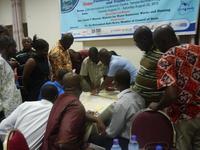IRC Ghana has organised a Life-Cycle Cost Approach (LCCA) training for participants at the Mole Conference XXIII. The main message brought by facilitator Dr Nyarko, country director for WASHCost Ghana, was the need to properly budget for activities throughout the life-time of a system and he introduced participants to the various cost components involved.
Published on: 03/09/2012
IRC Ghana has organised a Life-Cycle Cost Approach (LCCA) training for participants at the Mole Conference XXIII. The training was in collaboration with the Kwame Nkrumah University of Science and Technology, WASHCost Project Ghana and the Coalition of NGOs in Water and Sanitation (CONIWAS).
The training was aimed at building the capacity of participants, drawn from Civil Society, governmental agencies and the private sector, to be able to budget for the life time of facilities to ensure sustainability of service delivery.
Country Director for the WASHCost Project in Ghana, Dr Kwabena Nyarko, who facilitated the training, said the provision of sustainable water, sanitation and hygiene services goes beyond the initial cost of providing the facility. He remarked “the challenge is with activities at the post construction stage; when the people begin to enjoy the service, how do you sustain that service?”.
Dr Nyarko emphasised the need to properly budget for activities throughout the life-time of a system and introduced participants to the various cost components involved.

He said the various cost components of the LCCA include Capital Expenditure (CapEx) - the capital invested in constructing water facilities such as boreholes, pumps, reservoirs and pipes. Operational and minor maintenance expenditure (OpEx) - expenditure on minor repairs, labour, fuel, chemicals, materials, or regular purchases of bulk water. Capital maintenance expenditure (CapManEx) - expenditure on asset renewal, replacement and rehabilitation costs. It normally costs more than operational and minor maintenance.
Expenditure on Direct Support (ExpDS) - expenditure on support to local-level service providers, users or user groups. These are the costs for ensuring that local government staff have the capacities and resources to carry out planning and monitoring, to help communities when systems break down, to audit community management structures, to monitor private sector performance, to carry out regular hygiene awareness raising and so on. Expenditure on Indirect Support (ExpIDS) – expenditure on government macro-level planning and policy making, developing and maintaining frameworks and institutional arrangements, capacity building for professionals and technicians through university courses, technical schools etc. Cost of capital (CoC) – the cost for borrowing or otherwise acquiring the resources to provide the assets needed for a service. This is made up of interest payments on debt and dividend payment to equity providers.
Dr Nyarko said the methodology is the outcome of action research by the WASHCost Project with its partners. It aims at coming out with what actually constitutes the costs of WASH service provision. He said “so far the methodology has been tested in all WASHCost countries namely Ghana, Mozambique, Burkina Faso and Andhra Pradesh (India)”. He explained the Life-Cycle Cost Approach enables a comparison of different service delivery models internalising country norms, life spans, number of users and poverty analysis.
He urged participants to apply the knowledge acquired at the training to their work so they can properly budget for the construction of facilities with post-construction services in mind to ensure sustainability of service.
The Mole Conference is a water, sanitation and hygiene (WASH) sector event in Ghana, organised by CONIWAS to provide the platform for sector stakeholders to discuss and review activities and challenges confronting the sector and come out with recommendations to improve the situation.
This year’s edition of the conference took place at Tamale in the Northern Region from 21-24 August 2012, under the theme: ''Financing the WASH Sector: Past, Current Trends and Vision for the Future”.